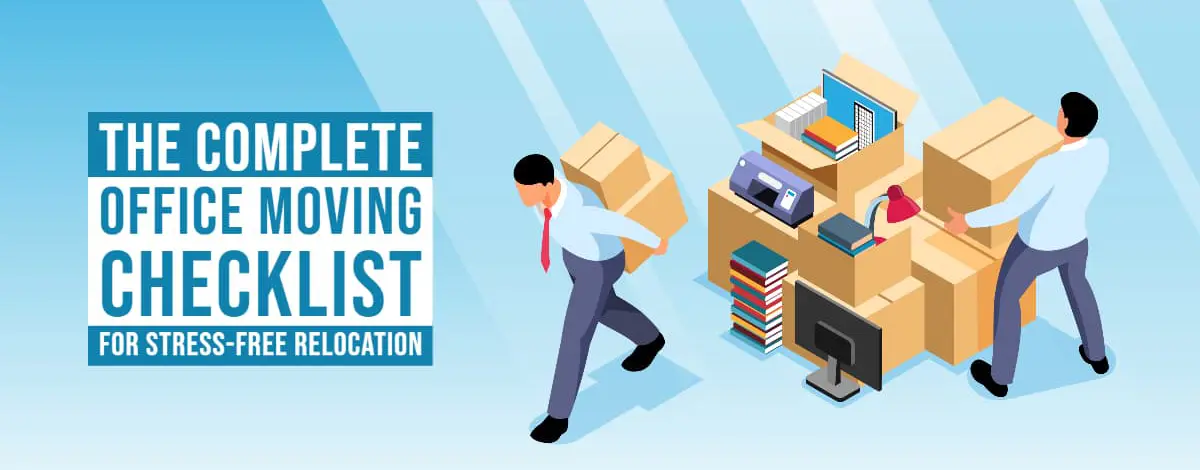There is typically not a lot of time available to complete everything about your office relocation (you can’t exactly halt activities for a week to resolve issues). Because of the size of your business, relocating your office is a lot of labor, whether you’re shifting to a new floor or across the nation. Utilize this checklist as a strategic plan if you’re looking to relocate to a new office location.
This is our detailed checklist to keep you on track.
Six Months Before Moving:
Here are some things to think about six months before moving your office.
Establish A Moving Crew Inside The Office:
Your shifting task managing crew should be given particular duties with clearly defined roles. Who is organizing, decorating, packing, and unwrapping?
Make A Budget:
Even if you wind up having to change it, knowing how much you could still have to pay upfront will be quite beneficial when you speak with the moving firms. Consider where you can cut back to save funds after deciding what things are non-negotiable. Think about the shopping procedure as well. Who will buy everything needed for the relocation, and how will the providers be paid?
Begin Looking Into Moving Companies:
All movers on our current list of top movers provide services for business relocation. A relocation consultant who has experience with commercial moves will often be assigned to you and will work with you to organize your particular transfer. Office relocation moving companies also typically have more flexibility with dates and hours and will try their best to shift your workplace, for instance, on the weekend to avoid disrupting your business operations.
Also Read: Hyderabad moving companies with pricing details
Find At Least Three Inspiring Quotations:
Get free quotes from a few movers after you’ve found one that can manage your commercial move and serve your neighborhood. We advise purchasing at least three. Office movers at 1Support are willing to provide you with free online moving quotations.
Prior To Your Move, Three To Four Months:
Set a relocation date in stone. Once your new office location has been confirmed, book a move with a moving company or make alternative moving arrangements.
Inform your present landlord. Tell your current property management when you intend to end your lease as soon as you have a firm date for your company’s relocation.
Create a moving strategy. Make a list of everyone engaged in the transfer, the tasks that must be completed, and the due dates.
Give team members tasks to do. Appoint leaders to manage the transition so that everyone knows what responsibilities they have.
Inform all staff members about the impending move.
Also Read: How to Prepare Your Employees for Office Move
Prior To Your Move, Two Months:
Construct a floor plan. Create a plan for your new and old offices to decide where to put furnishings, devices, and tables.
Set up the installation of your phone and the internet. Choose a business that can offer these services, then arrange the installation from there. If you’re dealing with a full-service office operator, they can probably coordinate this setup immediately with you.
Create a plan for installing computers and IT infrastructure. Check to see if your IT personnel can complete this on their own or if you need to bring in additional assistance.
Check entry cards, parking permits, and keys. Make a big list of all the keys and passes that each employee has, and use it as a guide when it comes time to gather any unpaid entry cards prior to the relocation day.
All unique services offered by your existing office should be stopped. Inform any present maintenance, surveillance, or cleaning providers of your relocation so they can stop providing their services once your business has left.
Month Prior To Your Relocation:
Make a list of and label all materials, furnishings, and devices. To prevent losing your company’s achievement trophies in transportation, mark and tag everything in your office. Moreover, remember to take pictures of your inventory as you classify it in case you have to go through the claims process.
Get your moving materials. Keep in mind your staff members have cartons, wrapping tape, and labeling supplies if they are boxing up their own tables.
Move the utilities. Schedule a date for the utilities at your present workplace to be canceled, and look into utility possibilities for your new site.
Make a list of address changes. Let your clients and customers know how they can contact you moving forward by sending an email or postal notice.
Publish updated firm addresses. Please change your current address for the following subscriptions, email lists, and websites so that your company doesn’t suffer during the transition.
Prior To Your Move, Two Weeks:
Make final your relocation team’s preparations. If packing and transporting will start while other areas of the office are still operating, make sure to include a clear schedule for the days preceding the move.
Order entry cards and passwords. Order the office’s keys in beforehand so that they may be distributed on a moving day.
Verify the installation of the phone and the internet. As soon as you shift into the new workplace, remember you’ve hired a staff to set up these facilities so that you may resume routine work.
Verify the setup of the PC and IT services. Make sure you’ve discussed who will handle it inside when your crew has the expertise to set up these programs. If not, be sure you’ve engaged qualified experts.
Reduce the inventory of the office. Do some cleaning work and reduce office inventory when your office has worn-out, old-fashioned equipment or interiors.
Back up critical data and documents. Create a backup of your information if you haven’t previously. Make sure to back up any important papers or data before the relocation in case anything is damaged during transportation or has trouble restarting at the new office.
The Week Prior To Your Relocation:
Prior to actually relocation day, inspect your new workplace. We advise checking your new space before moving in if you already have permission for it.
Examine the timetable for moving day. Discuss who has to be present to let the removalists in, what goods must be prepared for removalists once they arrive, who will be available during the relocation, and who will be in charge of closing the service after the removalists depart.
Remind staff to pack up their personal effects. However, if your business offers computers, microphones, and other IT devices to employees, you might want to reserve this responsibility for your IT department or your expert moving company. We advise holding employees accountable for their personal belongings.
The Morning Of Your Relocation:
Complete the labeling and packing. Assemble your keys, security cards, and parking permits. Collect the access cards for every worker using your itemized list. Assure their deactivation and proper disposal.
On The Day Of The Relocation:
To organize all of your furnishings, devices, and machines, go to the plan or layout you produced for your new office. This is where transition preparation will be useful if you’re dealing with a moving firm.
Connect the IT, internet, and phone networks. This service might be provided if you’re hiring a seasoned mover. If not, work with your neighborhood provider to make sure your office has complete connectivity.
Examine your abandoned office thoroughly and note any damage. This is crucial to inspect and document any property loss during the relocation, check for goods that need to be relocated to your new address, and see if you forgot anything.
As soon as you arrive at the new workplace, assign personnel to unpack, de-tag furniture and equipment, and restock supply cabinets. Assign staff the responsibility of unpacking and refilling if your expert movers haven’t already done so. You have more people on hand, and the quicker your company can resume operations.
FAQ On Office Moving Checklist
1. Describe the motivations for the office relocation. You must first and foremost understand the reasons behind the company’s decision to move.
2. Establish the amount of office space needed.
3. The Timeline, please.
4. Create a team for your relocation project.
5. Have a list handy.
1. Your to-do list when relocating to a new workplace.
2. Arrange your paperwork.
3. Choose the other items that will go in your moving binder.
4. List every appointment you have.
5. Keep track of the dimensions of the office furniture.
6. Start the first box’s packing.
7. Do a file backup.
8. Determine the type of move you are making.
9. Start looking into moving businesses.
1. Amass Referrals. Try to have a free quotation.
2. Adhere to the rule of three.
3. Watch out for warning signs.
4. Verify the removalist’s insurance and license status.
5. The Better Business Bureau should be consulted.
6. Consider becoming professionally accredited.
7. Check the address.




